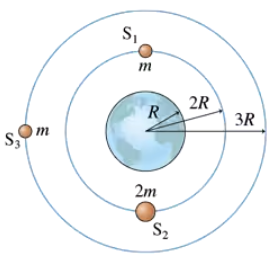 Back
BackProblem 2
What is the ratio of the sun's gravitational force on you to the earth's gravitational force on you?
Problem 4
The International Space Station orbits 300 km above the surface of the earth. What is the gravitational force on a 1.0 kg sphere inside the International Space Station?
Problem 5
What is the force of attraction between a 50 kg woman and a 70 kg man sitting 1.0 m apart?
Problem 6
Two 65 kg astronauts leave earth in a spacecraft, sitting 1.0 m apart. How far are they from the center of the earth when the gravitational force between them is as strong as the gravitational force of the earth on one of the astronauts?
Problem 8
What is the free-fall acceleration at the surface of (a) the moon and (b) Jupiter?
Problem 11
A recently discovered extrasolar planet appears to be rockier and denser than earth. It is 16 times as massive as earth, but its diameter is only twice that of earth. What is the free-fall acceleration on the surface of this planet?
Problem 12
Asteroid 253 Mathilde is one of several that have been visited by space probes. This asteroid is roughly spherical with a diameter of 53 km. The free-fall acceleration at the surface is 9.9 ✕ 10-3 m/s2. What is the asteroid's mass?
Problem 14
Suppose we could shrink the earth without changing its mass. At what fraction of its current radius would the free-fall acceleration at the surface be three times its present value?
Problem 15
What is the escape speed from Jupiter?
Problem 17
A rocket is launched straight up from the earth's surface at a speed of 15,000 m/s. What is its speed when it is very far away from the earth?
Problem 18
A space station orbits the sun at the same distance as the earth but on the opposite side of the sun. A small probe is fired away from the station. What minimum speed does the probe need to escape the solar system?
Problem 19
Two stars, one twice as massive as the other, are 1.0 light year (ly) apart. One light year is the distance light travels in one year at the speed of light, 3.00 ✕ 108 m/s . The gravitational potential energy of this double-star system is - 8.0 ✕ 1034 J. What is the mass of the lighter star?
Problem 20a
You have been visiting a distant planet. Your measurements have determined that the planet's mass is twice that of earth but the free-fall acceleration at the surface is only one-fourth as large. What is the planet's radius?
Problem 20b
You have been visiting a distant planet. Your measurements have determined that the planet's mass is twice that of earth but the free-fall acceleration at the surface is only one-fourth as large. To get back to earth, you need to escape the planet. What minimum speed does your rocket need?
Problem 21
Nothing can escape the event horizon of a black hole, not even light. You can think of the event horizon as being the distance from a black hole at which the escape speed is the speed of light, 3.00 ✕ 10⁸ m/s, making all escape impossible. What is the radius of the event horizon for a black hole with a mass 5.0 times the mass of the sun? This distance is called the Schwarzschild radius.
Problem 22
A binary star system has two stars, each with the same mass as our sun, separated by 1.0 ✕ 1012 m. A comet is very far away and essentially at rest. Slowly but surely, gravity pulls the comet toward the stars. Suppose the comet travels along a trajectory that passes through the midpoint between the two stars. What is the comet's speed at the midpoint?
Problem 24c
Three satellites orbit a planet of radius R, as shown in FIGURE EX13.24. Satellites S1 and S3 have mass m. Satellite S2 has mass 2m. Satellite S1 orbits in 250 minutes and the force on S1 is 10,000 N. What is the kinetic-energy ratio for K1 / K3 for S1 and S3?
Problem 26
The asteroid belt circles the sun between the orbits of Mars and Jupiter. One asteroid has a period of 5.0 earth years. What are the asteroid's orbital radius and speed?
Problem 27
A satellite orbits the sun with a period of 1.0 day. What is the radius of its orbit?
Problem 28
A new planet is discovered orbiting the star Vega in a circular orbit. The planet takes 55 earth years to complete one orbit around the star. Vega's mass is 2.1 times the sun's mass. What is the radius of the planet's orbit? Give your answer as a multiple of the radius of the earth's orbit.
Problem 30
A small moon orbits its planet in a circular orbit at a speed of 7.5 km/s. It takes 28 hours to complete one full orbit. What is the mass of the planet?
Problem 31b
The Parker Solar Probe, launched in 2018, was the first spacecraft to explore the solar corona, the hot gases and flares that extend outward from the solar surface. The probe is in a highly elliptical orbit that, using the gravity of Venus, will be nudged ever closer to the sun until, in 2025, it reaches a closest approach of 6.9 million kilometers from the center of the sun. Its maximum speed as it whips through the corona will be 192 km/s. The probe's highly elliptical orbit carries it out to a maximum distance of 160 Rs with a period of 88 days. What is its slowest speed, in km/s?

